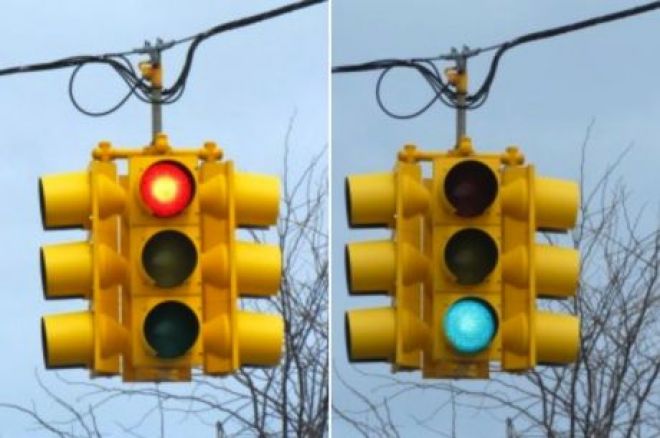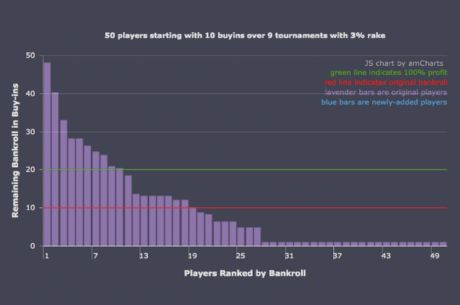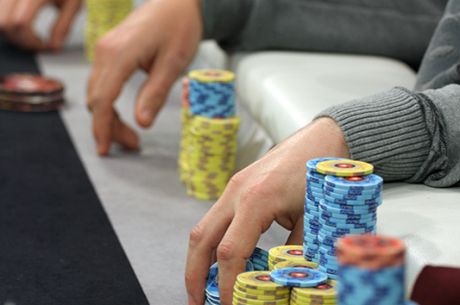Making Moves: The Stop-and-Go in Tournament Poker

When you are short-stacked in a no-limit hold��em tournament �� say, down to less than 10 big blinds �� your options are necessarily limited. In a lot of cases, you really only have one ��move�� left that is available to use, and that��s an all-in raise or reraise before the flop.
Say the blinds are 300/600 with a 75 ante and you only have 4,000 chips. You don��t have enough to make a standard raise before the flop and then make a continuation bet afterwards. It would take more than half your stack to play a hand that way, and so you aren��t deep enough to play in such a ��straightforward�� manner.
Thus you��ll typically either be waiting to be dealt a decent hand with which to shove all in, or perhaps will look for the first opportunity to open-raise all in, say, when the table folds to you in middle or late position.
The stop-and-go play, however, represents a second possible move that can be employed by the short stack hoping to survive further in a tournament. Let��s look at an example.
The ��stop-and-go�� defined
In truth, the stop-and-go play consists of two moves, but it is best thought of as a single ��move�� that like the all-in preflop push is dictated by the player��s willingness to get all of his or her short stack in the middle.
Here is how the ��stop-and-go�� works. Say again that the blinds are 300/600 with a 75 ante and a player in the big blind with a stack of 4,000 looks down to see A?10?. It folds around to the button who raises to 1,200 and the small blind folds. Rather than shove all in, the short-stacked player just calls the raise, and after the flop comes then pushes all in with his remaining chips.
Think of it as an all-in shove but with that pause in between �� the ��stop�� (or call of the raise), then the ��go�� (the push after the flop).
So what��s the point of playing a hand this way? Why not just reraise all in when you��re down to about seven big blinds (like this player) and you��ve finally been dealt a decent hand like A?10??
Increasing the chance of winning the hand
The primary reason for the short-stacked player to play his hand this way is to increase the likelihood that his opponent will fold once he��s committed his stack, even by just a little. By employing the stop-and-go, the short-stacked player can increase his ��fold equity�� in the hand.
One of the most obvious problems short-stacked players have in tournaments is being able to get their opponents to fold when they push their short stacks all in. In other words, they have little ��fold equity�� or chance to win a hand by getting an opponent to fold, and thus usually must show down a hand to win.
That��s one reason why you generally should never let yourself get down to five big blinds or less in a tournament, because when you do finally push all in, calling your raise becomes somewhat trivial to others and you may well find yourself having to outdraw multiple opponents in order to survive.
The stop-and-go play can, however, earn a short-stacked player a little extra chance to get a fold from an opponent by delaying the all-in shove until after the first three community cards arrive.
The same pot odds, a different decision
Let��s look at that above example again to show how the stop-and-go can give the short-stacked player an extra chance to win a hand by getting an opponent to fold.
The button raises to 1,200 and the short-stacked player in the big blind calls. Let��s say it��s a nine-handed table, so counting the antes (675), the small blind (300), and the contributions of the button and the big blind (2,400), the pot is now 3,375. Meanwhile, the short-stacked player in the big blind now has 2,800 left behind, which he then shoves all in after the flop.
The button is now looking at having to call 2,800 to win a pot of 6,175 �� that��s pot odds of a little better than 2-to-1, which means he��d want to believe he has around a 1 in 3 chance (or better) of winning the hand to justify calling.
What if the big blind had just decided to push all in with a reraise-shove of 4,000 total before the flop? It��s precisely the same situation in terms of pot odds for the button �� there would be 6,175 in the middle, and he��d have to call 2,800 to stay in the hand.
So what��s the difference? The three community cards.
By the way, you��ve noticed we haven��t even mentioned what three cards came on the flop in our example. That��s because it doesn��t matter. Once you��ve committed to playing a hand in the stop-and-go manner, you��re essentially prepared to shove the flop regardless of what cards come. The short-stacked player may well miss the flop with his A?10? �� but the button probably will miss it, too.
The chance of flopping a pair or better when holding two unpaired cards is only 32.4%. That means two out of three times, the flop isn��t going to bring improvement to the button��s hand should he have two unpaired cards.
And if he has a pocket pair �� which is itself relatively rare (only coming 1 in 17 hands) �� he still might not like the looks of flop containing cards higher than his pair. Say he has 5?5?. Almost all flops are going to bring higher cards. If the flop comes K?J?7? and the short-stacked player pushes all in, the button will be a little more inclined to fold even though the pot odds are identical to what he faced before the flop. Meanwhile with a pocket pair (and a made hand) before the flop, he most likely would��ve called a reraise-shove.
So the button folds after the short-stacked player��s stop-and-go shove, and the short-stacked player picks up a healthy boost to his stack. Not only that �� he had the worst hand!
You��re probably thinking ��What if the flop does hit the button��s hand and he calls?�� Say that K?J?7? flop comes and you push all in with your A?10? and he��s sitting there with K?Q?. He��ll call all right. But he would��ve called your shove before the flop, too, and so the outcome is the same.
Use caution with the stop-and-go

For the stop-and-go to be a viable option, you need a short stack that is still big enough to earn a fold after that flop shove �� i.e., around 7-10 big blinds. Also, be aware of other aspects of the table dynamics that can affect whether or not the play is warranted. You��ll especially want to be cognizant of your opponent��s tendencies and whether or not a postflop shove is actually going to get that fold.
There will be some situations when it will still simply be better to reraise all in before the flop. But know that when short-stacked in a tourney you aren��t necessarily down to a single move.
Photos: ��Traffic Light,�� Kate Ter Haar (top); ��Traffic Light,�� Adnan Yahha (bottom). Creative Commons Attribution ShareAlike 2.0 Generic.
Get all the latest PokerNews updates on your social media outlets. Follow us on Twitter and find us on both Facebook and Google+!








